Farewell to Departing Faculty
The UF College of Education bids farewell to four departing faculty.
The UF College of Education bids farewell to four departing faculty.
MDLinx
8-9-13
Linda Behar-Horenstein
MDLinx, a website that provides medical research knowledge, featured a research article by Linda Behar-Horenstein, a College of Education faculty member who is also an affiliate faculty member at UF’s College of Dentistry. The article discusses Behar-Horenstein’s study of valid and reliable instruments used to measure and assess dental students’ cultural competence.
Gainesville Sun
2-22-13
Linda Behar-Horenstein
Linda Behar-Horenstein, a UF distinguished teaching scholar and professor in higher education administration, wrote an essay as part of her work as a member of UF’s Academy of Distinguished Teaching Scholars, which comes up with ideas and implements programs to further UF’s state as a research institution that values teaching.
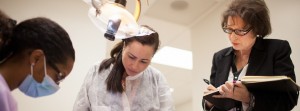 Sixteen years ago, Linda Behar-Horenstein, a distinguished scholar and professor in UF’s College of Education, was teaching a course on curriculum. What she didn’t know was that one of her students was going home at night and enthusiastically talking about it to her husband, who happened to be the associate dean of research for the College of Dentistry. Word soon traveled, and Behar-Horenstein received an invitation from then dean Frank Catalanotto to meet.
Sixteen years ago, Linda Behar-Horenstein, a distinguished scholar and professor in UF’s College of Education, was teaching a course on curriculum. What she didn’t know was that one of her students was going home at night and enthusiastically talking about it to her husband, who happened to be the associate dean of research for the College of Dentistry. Word soon traveled, and Behar-Horenstein received an invitation from then dean Frank Catalanotto to meet.
“The meeting wasn’t even two minutes,” she says. “He said, ‘OK, this what I would like you to do. I want you to go out to all the clinics and I want you to find out to what degree are the faculty promoting critical thinking skills among our students.’ That was my assignment.”
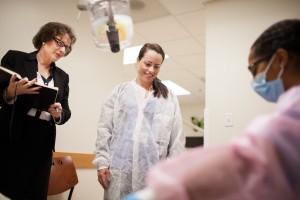
COE professor Linda Behar-Horenstein (left) observes a dentistry professor and student during a patient visit. (Photos by Maria Farias/UF&Shands)
Armed with only a notepad, Behar-Horenstein conducted 44 observations at six clinics. She watched dental faculty work with students as they themselves worked with patients, and she scribbled down everything she saw them say and do. When she was done, she analyzed her notes for commonalities, characteristics, recurring behavior and techniques. Then she brought her findings to the associate dean of education.
“She was just like, ‘You got this all from an observation?’”
Thus began Behar-Horenstein’s long relationship with the College of Dentistry. Over the years, she’s taught dentistry faculty alongside her graduate education students, run seminars on different teaching methodologies, written 10 papers pertaining to dentistry and worked one-on-one with dentistry faculty who want to improve their teaching evaluations.
Education and health care: It’s an odd match of disciplines, at least at first glance. The College of Education conjures up images of lesson plans, curricula and schoolteachers in training. For the six colleges in UF’s Health Science Center, people think of labs, white coats or hospital corridors.
Both disciplines are more diverse and expansive than a few clichés capture — but it may still be surprising how often the College of Education teams up with UF’s health colleges. Education students work in clinical practices. Education faculty share office space with health-focused colleagues. They partner with health care researchers on grants, contribute to health curricula and teach everyone from doctors to dentists how to be better teachers. They show health care professionals the world through the lens of a classroom.
“Any time two disciplines overlap, you have a possibility to create something completely new,” says David Norton, UF’s vice president for research. “With the Health Science Center, education is essential to their mission — educating students and their patients. In the College of Education, you have people who focus on just that. Very interesting things can emerge when those two things combine.”
Teaching teachers
So why is it worthwhile to develop the teaching skills of clinicians and researchers in the first place?
“What we do in our teaching is going to impact the kind of provider that’s going out into the world,” Behar-Horenstein says. “And that provider is going to impact the kind of patient-provider relationships they have.”
During her time with the College of Dentistry, Behar-Horenstein has gone from being a consultant to an affiliate professor, and last year she even received an office as part of a federal grant that expanded her role further. Recently, she developed a series of online courses for faculty that focus on teaching techniques.
“We as faculty are trained to be dentists, but we don’t have a special knowledge of teaching,” says Catalanotto, a professor and chair of community dentistry and behavioral science. “So having a collaborator like Dr. Behar-Horenstein brings us a new set of skills. That’s why we originally asked her to come the college in 1996, because we recognized that we needed help with teaching issues.”
Kent Crippen is another education professor who’s helping educators expand their repertoire, but in this case, it’s high school teachers.
Crippen is a consultant for Biomedical Explorations: Bench to Bedside, a two-week summer program for high school science teachers. The program is part of the Center for Precollegiate Education and Training, which connects educators to more than 350 UF faculty researchers to promote math and science in secondary school classrooms.
Crippen, an associate professor of science, technology, engineering and mathematics, or STEM, education, uses his knowledge of the K-12 school system to help translate the projects for classroom use.
“We struggle in K-12 education to present authentic science experiences that students can engage in, enjoy and learn from at the same time,” Crippen says. “Bench to Bedside takes new and emerging science and translates it to appropriate experiences for students to learn from.”
Through the center’s programs, high school teachers can stay current with modern technology and teaching techniques. The program, now in its third year, is expanding to support small groups of teachers throughout Florida who want to continue the professional development initiated in the program. Crippen will help them develop curricula and measure results and feedback.
Small group work
When asked what his typical day looks like, Erik Black, Ph.D., pauses, then laughs.
“I have three offices.”
There’s the cubicle at Shands at UF, the pediatric outpatient clinic office, and the office at the College of Education. In other words, there aren’t a lot of typical days for this assistant professor, who’s held a primary appointment in pediatrics and a secondary appointment in the College of Education since 2009. Black teaches and has graduate education students and does his own research for pediatrics.
“While many people traditionally think about the College of Education in a K-12 format, there are a number of us who are actively involved in adult education, and that’s where I focus most of my career: how to effectively educate adults,” Black says.
He’s currently serving as the educational technology expert for the Interdisciplinary Family Health course, which brings 600 first-year students from six colleges together to visit and help local families. At the end of last year, the program was expanded to include second-year students, and Black was involved from the beginning stage, developing basic goals, through the design and delivery of the curriculum.
“There is a real desire on the part of the administration to continue more interprofessional learning experiences,” Black says. “So this is a real opportunity, since we’ve got six health science colleges within a couple blocks of each other, to get students working together.”
UF has programs in place specifically designed to encourage interdisciplinary research, Norton says. The Research Opportunity Seed Fund, for example, is an internal grant program specifically for interdisciplinary faculty research.
“We’re always interested in creating forums and venues where people can interact,” he says. “It’s one of the strengths of the University of Florida that we have 16 colleges on campus, most of them with strong research programs. New fields emerge.”
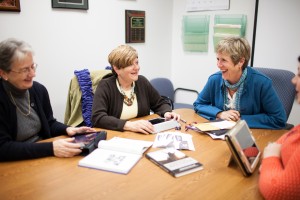
COE professor Jeanne Repetto (second from left) meets with an interdisciplinary team of “transition” health-care specialists from UF&Shands.
The Education and Health Care Transition certificate program emerged last summer under just such a collaboration. Four years ago, Jeanne Repetto, an associate professor in the College of Education, and social worker Susan Chauncey Horky, the co-director of the UF Pediatric Pulmonary Center, realized educators and health care professionals were approaching the same problem at two different angles — when instead, they should be working together.
The problem was “transition,” a term to describe how children with disabilities and/or health issues are prepared to succeed in adult life. From the educational standpoint, these children receive support and training at school to tackle transitioning into a university or job, as well as life skills. From the health care standpoint, children are likewise prepared to handle medical needs, such as ordering prescriptions and making appointments.
These two types of transition often operate independently of one another, with both sides unaware of the other, Horky says.
“I was sort of embarrassed when I realized there was a whole transition process in education,” she says. “You do get stuck in your own mindset — we tend to think in the patient mode and the school thinks in the student mode. But from the family’s perspective, it’s only one kid going from childhood to adulthood, so why are these skills not integrated?”
Horky, Repetto and a small, interdisciplinary team including a pediatric cardiologist, a medical social worker, a health policy expert and a parent of a child with a chronic illness, started working to integrate the two transitions.
Years of biweekly meetings, joint research, journal articles, grant proposals and national presentations culminated in the Education and Health Care Transition program, a fully online certificate from UF that prepares graduate students and professionals from both fields to collaborate. It’s a new field, and the first class of medicine and education students from across the country will graduate this semester.
“Many of the students in the program are practitioners, so it will have an immediate impact,” Repetto says.
From the clinic to the classroom
It’s probably not that surprising that most collaborations between the Health Science Center and the College of Education involve the department of pediatrics. After all, children with disabilities often need help from clinical professionals to succeed in school — and sometimes those professionals need help bringing their findings into the classroom.
“Collaborators with educational backgrounds, particularly those related to childhood — childhood education, how children learn, how they adapt to their environments — have real expertise that we can learn from as we develop programs in our department,” said Scott Rivkees, a professor and chair of pediatrics.

UF neuropsychologist Kristin Radonovich (left) and COE professor Maureen Conroy (right) often meet at Norman Hall to discuss their grant project.
Maureen Conroy, says that finding collaborators is like making friends; you look for similar interests. For Conroy, a College of Education professor, that interest was autism research.
It led her to seek out others on campus with the same interest, like neuropsychologist Krestin Radonovich. The two recently teamed up on an Office of Research grant to improve the social competence of children with autism spectrum disorders.
“To teach children social skills, they need to socially interact with other people,” says Conroy, co-director of UF’s campuswide Center for Excellence in Early Childhood Studies, headquartered at the College of Education. “Kids in the lunchroom or the playground usually play with each other, but children with autism don’t necessarily know how to do that. They stand by themselves. This will teach them how to play with the other children and will also teach the other children how to play with them.”
Their project is currently in the planning phase, but eventually Conroy and Radonovich will take strategies that promote social behavior directly into schools and work with children with autism.
Testing out strategies that were developed in clinics in schools is part of what makes this study unique, Radonovich says. It’s also where Conroy’s expertise comes in.
“For kids, their everyday life is largely at school and that’s where these interactions take place,” Radonovich says. “I want my work to be relevant, so to work with Dr. Conroy in a naturalistic school setting helps me to bridge that gap between the isolated clinic setting and real life for these kids.”
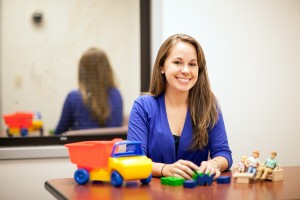
School psychology student Jill Welsh uses toys while working with children in the psychology clinic at UF&Shands.
The College of Education also makes its mark in UF and Shands clinics. Several doctoral students in the school psychology program work in the pediatric clinic to gain experience working with children.
“I realized that working with kids who have a communication deficit is what I love,” says Jill Welsh, a fourth-year doctoral student. “My passion is trying to find ways to communicate with them.”
That passion is put to use in the UF Psychology Clinic, where Welsh has worked under Radonovich for two years, working with children with autism spectrum disorders.For 15 hours a week, she performs assessments and runs therapy groups alongside clinical psychology students. The education students contribute insight into the educational side of patients’ lives, such as knowing what strategies are feasible in school and consulting with teachers, Welsh says.
“It’s their experience in the school system and their training that helps inform me and other trainees who work with them how our recommendations can better match the school setting, or what our expectations should be,” Radonovich says.
Making the grade
It’s clear that the Health Science Center benefits from collaborating with faculty and students within the College of Education.
“In general, any time our faculty have a chance to collaborate with faculty outside of the college, it broadens our faculty’s knowledge base,” says Thomasenia Adams, associate dean of educational research in the College of Education. “When our faculty collaborates with the Health Science Center, we find other ways of applying our expertise and crafts.”
It’s always a plus when they can see other perspectives, Adams says. For example, both entities view clients differently. In the College of Education, clients are primarily teachers and the children they serve; in the Health Science Center, they’re primarily patients. Seeing how each serves and responds to their clients — especially when they overlap — can improve their overall approach, she says.
“It can be challenging when we meet people who have different approaches, but challenges help us grow as scholars.”
CONTACTS
Writer: Marilee Griffin, UF&Shands Communications, margri@ufl.edu; 352-273-7891
COE Source: Larry Lansford, news and communications, UF College of Education, llansford@coe.ufl.edu; 352-273-4137
UF&Shands’ The Post
February 2013
Collaborations between the College of Education and UF’s health colleges
The Post wrote an article about the relationship between the College of Education and UF&Shands that is helping improve health education and health care. Linda Behar-Horenstein, Kent Crippen, Erik Black, Jeanne Repetto, Maureen Conroy, and Thomasenia Adams are quoted.
For years, University of Florida education scholar Linda Behar-Horenstein has dreamed of helping UF dental faculty sharpen their teaching skills and chairside manner as they perform precise dental procedures on their patients.
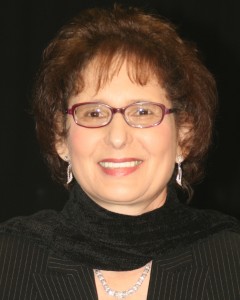
Behar-Horenstein, who has been teaching at the College of Education Department of Educational Administration and Policy since 1992, has always had an interest in the communication between health-care teaching professionals and their students and patients.
Her dream was realized when the College of Dentistry recently received a five-year $2.5 million grant from the Health Resources and Services Administration, a division of the U.S. Department of Health and Human Services.
Behar-Horenstein, co-principal investigator for the grant, has been working with the College of Dentistry since 1996, when she was asked
to observe the extent to which faculty were promoting critical thinking skills in clinics. Today, she is an affiliate professor in the college’s Department of Community Dentistry and Behavioral Science, as well as a Distinguished Teaching Scholar in both the colleges of Education and Dentistry.
The grant’s focus is on enhancing faculty’s teaching repertoire through instruction, and incorporating cultural competency and motivational interviewing, among other skills that are important for serving dental patients. The dental school received another grant three years ago worth $3.5 million aimed at providing pre-doctoral dentistry students with similar patient-centered skills.
“The idea is to help develop new and better skills in our faculty,” said Frank Catalanotto, who first invited Behar-Horenstein to the college about 16 years ago when he was dean. Catalanotto is the co-principal investigator for the grant. “If the grant is successful, our students will be better dentists when they go out into practice. Better dentists are going to improve the health of the public.”
Behar-Horenstein first became fascinated with professors’ differing teaching styles after taking a course with a frustrating professor in graduate school. When she realized she would have to teach herself the material, Behar-Horenstein started studying the styles of all her instructors, making a mental inventory of strategies that either promoted or prevented student learning.
“This issue is very important to me because I think professors’ research and training greatly affects the teaching that their students receive,” said Behar-Horenstein.
Over the years, she has traveled across the country showing instructors how to teach critical thinking and active learning skills. Behar-Horenstein now enjoys discussing with UF dentistry professors how to be engaging, interactive and productive in their teaching.
“The grant supports faculty in teaching pre-doctoral students how to become patient-centered in their communication,” Behar-Horenstein said. “If faculty haven’t had the opportunity to learn these teaching skills, it will be very difficult to model that.”
As a co-PI for the latest federal grant, Behar-Horenstein will lead online classes, webinars and presentations for faculty and help them with research projects and surveying their progress in the classroom and clinical learning environments
“I’m an internal resource because they can come to me seeking counsel or advice,” Behar-Horenstein said. “Talking with a colleague who understands teaching sometimes opens doors for others who may be experiencing challenges and reassures them that it’s really OK. We all go through this. Being an instructor requires growth and reflection.”
SOURCE: Linda Behar-Horenstein, distinguished teaching scholar and professor at UF College of Education, distinguished teaching scholar and affiliate professor at UF College of Dentistry; lsbhoren@ufl.edu; 352-273-4330
WRITER: Alexa Lopez, new media coordinator, news and communications, UF College of Education; aklopez@coe.ufl.edu; 352-273-4449
MEDIA LIAISON: Larry Lansford, director, news and communications, UF College of Education; llansford@coe.ufl.edu; 352-273-4137
Gainesville Sun, Ocala Star-Banner
10-26-12
Linda Behar-Horenstein
The Gainesville Sun and the Ocala Star-Banner quoted Behar-Horenstein in an article about a $2.5 million grant that was awarded to the College of Dentistry for the improvement of faculty education. Behar-Horenstein, who has a co-affiliation with the College of Dentistry and College of Education, is the co-principal investigator for the grant.
Like most new teachers, Melissa Singleton entered her first classroom 17 years ago with high expectations for her students’ success. What she didn’t expect were cultural barriers that would shape the topic of her doctoral dissertation study at UF’s College of Education.
Singleton, who graduated recently with her Ph.D. in educational leadership, said she had trouble communicating with most of her students as a novice teacher because she wasn’t in tune with their ethnic backgrounds.
Her students, mostly African American, used words like “flawjin’” and other slang that Singleton had never heard before. She reached out to one of her students to teach her current slang and help her understand their music, hairstyles and fashion. Turns out “flawjin’” means to put on a front. Singleton learned more teen pop-culture lingo, listened to her students’ music and allowed them to pick her nail polish if they did well on their tests. She even learned the crochet method of hair braiding that was popular among black girls.
“You talk about teaching moments, but you have learning moments as teachers, too,” Singleton said.
She always took the time to connect with her students—whom she affectionately refers to as “my kids”– because she knew that was the only way she could gain the credibility and trust needed to motivate them. The relationship-forming didn’t take too much time, either. She’d eat lunch with her students or talk with them in the classroom, hallway or during planning periods.
Singleton taught subjects from math to reading in regular and special education classrooms at several schools before her promotion in 2010 to assistant principal at Kanapaha Middle School in Gainesville, where she continued to work while pursuing her doctorate at UF.
It was her early, challenging teaching experiences that inspired her dissertation research on black males’ perception of their high school success. She wanted to know why some African-American male students were responsive and successful in her class and not in other subjects.
She interviewed and held focus groups with seven randomly selected, black male students from a North Central Florida high school, all with different backgrounds: some came from stable families and others came from living situations that would make graduating high school seem like an insurmountable feat.
The seven black males in her study agreed that academic success, to them, meant having a 2.5 grade point average, which amounts to As and Bs with a few Cs, and being able to play sports, which requires at least a 2.0 GPA. Even though none of the students averaged at least 2.5, they all said it is something they’d like to achieve.
From her research, Singleton concluded that family, educational and peer relationships all play a part in a student’s success. All seven students agreed that the relationship with their teachers profoundly influences their academic success.
“Students work for teachers who make them feel good about themselves,” said Linda Behar-Horenstein, a UF distinguished teaching scholar and professor in higher education administration and Singleton’s doctoral chair. She said Singleton’s research reinforces the importance of relationships between teachers and students and cultural awareness.
One student in Singleton’s study, referring to a teacher he didn’t get along with, said, “I was failing her class because I couldn’t stand her. I don’t like English, and she wasn’t patient and always had an attitude; it was like somebody stomped on her foot or something every time I saw her.”
That same student–the son of a single mother in jail, being raised by his 21-year-old sister with two young children of her own, said school was the only place he could get away from the drama and chaos in his home life. Yet he was failing some of his favorite courses because he was taken out of school so often to take care of his sister’s kids.
Behar-Horenstein said teachers should realize that when students are rude, it’s cause for a conversation to understand why the student is behaving that way. She said it doesn’t take time or money to do that, it just takes an “I want to” from the teacher.
After her study, Singleton concludes that teaching is about relationships and trust; she incorporates her findings into her job as assistant principal. She suggests school administrators should provide group training to prepare teachers to be better relationship builders with all students.
“There has to be a way to teach relationship building and cultural awareness,” Singleton said. “Everyone can grow – from the top down.”
She said that while her study focused on black males, the findings transcend race, culture and ethnic background.
“Educators must be able to understand students as individuals,” she said. “We have to be able to meet them where they are– academically, personally and emotionally. Only then can we help them reach their greatest potential.”
CONTACTS
WRITER: Jessica Bradley, student intern, news & communications, UF College of Education, 273-4449
MEDIA RELATIONS: Larry Lansford, director, news & communications, UF College of Education, 352-273-4137; llansford@coe.ufl.edu
College of Education
140 Norman Hall
PO Box 117040
Gainesville, FL 32611-7044
(352) 392-0726
